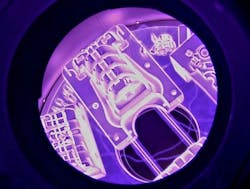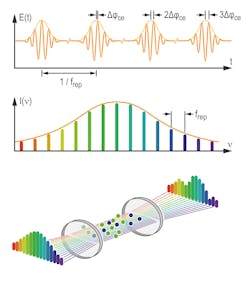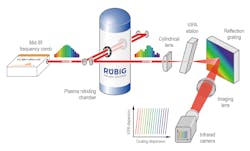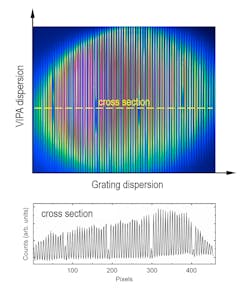Industrial surface hardening: Shining a light on process control
Plasma science, industrial surface hardening, and frequency combs: at first glance, not your everyday combination of subjects. But a project consortium is bringing together experts from the Leibniz Institute for Plasma Science and Technology (INP), neoplas control, RÜBIG, and Menlo Systems to tackle a blind spot in process control of plasma-based surface treatments. Their goal is to significantly reduce use of energy and resources, and to set new standards in environmental sustainability. It’s worth illuminating one field at a time to better understand what motivated the project and the technical challenges involved.
Plasma
As to plasma itself (see Fig. 1), it’s defined as the fourth state of matter, a quasineutral medium of charged particles (i.e., ions and electrons), but typically also an admixture of neutral atoms and/or molecules, in which all particle interactions are predominantly collective. It can be technically produced by sheer heating of matter or exposure to a strong electromagnetic field.Notably, plasmas are a kind of “hidden champion” among the states of matter, since more than 99% of all visible matter within the universe is in the plasma state. Artificially generated and technically applied plasmas, on the other hand, are mostly more difficult to see, as their traces remain hidden somewhere inside the device or product. Technical applications of plasmas are highly diverse and relevant to everyday life, ranging from agriculture, over medicine and life sciences, to material processing technologies like plasma nitriding.1
Plasma nitriding
So-called nitriding and nitrocarburizing processes enhance the hardness, wear resistance, and fatigue strength of metallic surfaces via diffusion of nitrogen and/or carbon. This results in metallic surfaces highly resistant to abrasion and wear, which are in high demand across various industrial sectors, including automotive and aerospace, as well as toolmaking. Among different industrial processes for nitriding of iron and steels, it is the oldest nitriding technology, gas nitriding, that is currently still most widely used. In essence, gas nitriding is carried out at high temperatures using ammonia as the main nitrogen source. The heating of ammonia is energy-intensive and possesses a risk of explosion within the presence of oxygen, so costly safety precautions must be taken. More severely, it is the high emission of nitrogen and carbon oxides during the process that leaves a high ecological footprint.
In plasma nitriding (see Fig. 2), in turn, the reactivity of the nitriding media is not due to high temperature, but rather derives from plasma-generated reactive species—i.e., ions and radicals that diffuse into the surface of the workpieces. The workpieces are treated at low pressures in a gas discharge of environmentally friendly gases such as nitrogen and hydrogen, avoiding the use of toxic ammonia (as common in gas nitriding).Among the biggest advantages of plasma nitriding are its better energy and resource efficiencies, and much lower environmental impact. Material consumption in plasma nitriding, for example, is about 10 times less than in gas nitriding, and the amount of nitrogen and carbon oxides emitted is more than three orders of magnitude lower. Also, plasma nitriding does not require particular safety precautions (the process atmosphere is nonexplosive), requires less space (as smaller gas storage tanks are needed), and can be typically easily integrated into existing factory infrastructure (it does not use or generate any toxic fumes). Overall, plasma nitriding is an innovative and eco-friendly solution with strongly reduced use of energy and materials.
Laser spectroscopy for process control
A remaining challenge in plasma nitriding is process control. So far, static process control based on empirical values provides only limited insight into the complex process chemistry, which hampers optimization and method development. For a dynamic, closed-loop process control, obviously an in situ concentration determination of the plasma-generated reactive molecular species is required. Yet, until now, such investigations mostly originated from work in scientific research facilities.
Laser-based absorption spectroscopy (LAS) appears as a method of choice for in situ determination of process relevant molecules. It is the mid-infrared (mid-IR) spectral region, where these molecules exhibit strong absorption cross-sections. LAS is noninvasive and capable of providing absolute concentrations without calibration, and with excellent selectivity and sensitivity. Using narrowband continuous-wave (CW) lasers, quantitative in situ detection of stable and transient species in plasmas has been successfully demonstrated.2 However, the typical narrow spectral working range of such CW lasers limits the number of traceable species per laser.
As a rule of thumb, one species per laser can be detected by LAS using narrowband CW sources. To detect several process relevant species, a spectrometer would need to be equipped with a corresponding number of laser light sources, which becomes expensive, complex, and prone to defects. It also would not provide information about rotational and vibrational temperatures, because of the limited number of covered absorption transitions for each individual molecular species. In short: this is where frequency combs come into play.
Mid-IR frequency combs
As illustrated in Figure 3, a frequency comb essentially relies on a mode-locked pulsed laser, emitting an ultra-stable train of ultrashort pulses. Once the pulse repetition rate (frep) and the carrier envelope phase (φCE) are fully stabilized, such a pulse train translates—in frequency domain—to a broad, comb-like spectrum composed of equidistant and narrow spectral lines.Originally a Nobel Prize-winning idea that pushed the limits of frequency metrology, frequency combs now enable new approaches to molecular spectroscopy of gases and plasmas. In an intuitive picture, a frequency comb replaces many thousands of CW lasers that all emit simultaneously, providing a convenient means to imprint line shapes of molecular absorption. Yet, achieving industrially practicable frequency-comb spectroscopy comes with quite a few challenges, especially for the mid-IR spectral range.
First, the technology behind generating an ultra-stable pulse train itself is crucial for robust, reliable, and ready-to-use instrumentation. For industrial applications, requirements are particularly demanding with respect to harsh environmental conditions. This has driven the design of fiber laser architectures for particularly robust femtosecond-pulse generation, like the figure-of-nine scheme (named after the characteristic shape of the cavity scheme used).3
Second, keep in mind that the spacing of comb spectral lines in the frequency domain are determined by the pulse repetition rate (the inverse of temporal pulse-to-pulse separation). In other words, the laser needs to be operated at a repetition rate adequate for capturing certain spectral features in the frequency domain. For typical conditions in plasma nitriding processes (pressures in the range of few millibars and temperatures in the range of hundreds of °C), absorption line profiles exhibit a broadening of a few-hundred megahertz. This pushes acceptable repetition rates into the range of 100 MHz or below, if adequate spectral resolution shall be achieved.
Overall, generating a suitable frequency comb in the mid-IR range is not straightforward. Direct sources of pulsed mid-IR laser radiation, which are basically available, either fall short in enabling the required repetition rate, cannot achieve sufficient power levels, or are excessively complex and bulky—or all the above.
Lacking suitable laser active media for direct mid-IR generation requires resorting to nonlinear frequency conversion of established sources, such as erbium- or ytterbium-doped femtosecond fiber lasers. Figure 4 illustrates a state-of-the-art ytterbium-doped femtosecond fiber laser as the primary pumping source (at 1040 nm). The primary output is split, and one part of the ytterbium fundamental slightly shifts towards longer wavelengths via the phenomenon of soliton self-frequency shifting (a power-dependent effect that can be exploited in a photonic-crystal fiber). Recombining the shifted wave with the fundamental wave for difference frequency generation (in a periodically poled lithium niobate crystal), mid-IR output at a 100 mW average optical output power level can be routinely achieved. Notably, such difference frequency generation-based frequency combs are “offset-free,” which means stabilization requirements are considerably simplified.Tested in a harsh industrial environment
Figure 5 shows the basic experimental scheme for probing a plasma nitriding process by a mid-IR frequency comb combined with a spectrometer of cross-dispersive type. The mid-IR frequency comb used typically covers a spectral bandwidth of well above 100 nm, allowing for simultaneous detection of multiple species in the plasma.For illustration, a sample 2D image is shown in Figure 6, which represents the spectrally cross-dispersed intensity of a frequency comb after transmission through the plasma nitriding reactor.
After verification of the VIPA detection unit at a lab-scale reactor,4 the practical implementation of the setup has recently undergone extensive testing during operation hours in a factory hall. Real-time monitoring of several process-relevant species in a nitriding plasma was accomplished for the first time under real-world conditions using frequency combs.
Outlook
Frequency comb-based spectroscopy of nitriding plasmas—via monitoring process-relevant species in situ and in real time—is paving the way to dynamic process control in industrial settings. While there are challenges ahead, the potential of market-ready control instrumentation is tantalizing to envision. More broadly, expect another surge in market acceptance of plasma nitriding technology, once the ecological benefits can be fully harnessed.
ACKNOWLEDGMENTS
The project was funded by the German Federal Ministry of Education and Research under grant number 13N14947. The authors gratefully acknowledge support in preparing the manuscript from Norbert Lang (INP), Henrik Zimmermann (neoplas control), Andreas Gebeshuber and Volker Strobl (RÜBIG), and Stefan Matern and Marc Fischer (Menlo Systems).
REFERENCES
1. R. Grün and H.-J. Günther, Mater. Sci. Eng. A, 140, 435 (1991); https://doi.org/10.1016/0921-5093(91)90459-z.
2. J. Röpcke et al., Photonics, 3, 45 (2016); https://doi.org/10.3390/photonics3030045.
3. W. Hänsel et al., Appl. Phys. B, 123, 41 (2017); https://doi.org/10.1007/s00340-016-6598-2.
4. I. Sadiek, N. Lang, and J. H. van Helden, Optical Sensors and Sensing Congress (2022); https://opg.optica.org/abstract.cfm?uri=lacsea-2022-lm4B.5.
About the Author
Ibrahim Sadiek
Research Scientist, Leibniz Institute for Plasma Science and Technology
Ibrahim Sadiek is a research scientist at the Leibniz Institute for Plasma Science and Technology (Greifswald, Germany). With expertise in frequency comb spectroscopy also using optical cavities, he holds a Ph.D. in physical chemistry from the University of Kiel (Germany).
Jaroslaw Sperling
Business Developer, Femtosecond Fiber Lasers at Menlo Systems
Jaroslaw Sperling is business developer for femtosecond fiber lasers at Menlo Systems (Martinsried, Germany). With a background in ultrafast laser spectroscopy, he holds a Ph.D. in physical chemistry from the University of Vienna (Austria).






